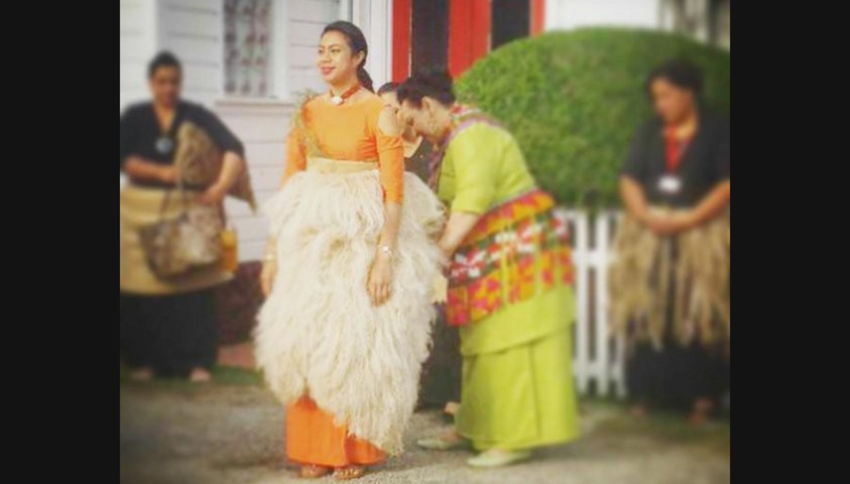IE SINA

"I remember the feeling of fear and heat, all at once, as the mat was tied firmly to my waist. It was thick, heavy and white all around me, but there were also red shades.
My job was simple; perform with finesse and do not faint. That was indeed my first time wearing an ie sina to dance".
- Va'asiliifiti Tuisafua Moelagi Jackson
The above scene is something I have pictured so many times in my mind, because there are not many images of my mother as a teenager. Her stories, proudly corroborated by my late grandmother Faleasiu and some who were there were we had to go by.

My fascination with their stories of dance and the accompanying teuga; headpieces, elaborated twisted and woven necklaces, mats and pandanus creations that layer the dancer’s body intrigued me. But it led me down many disappointing paths when I discovered that the material culture of their time are largely confined to black and white images, Museum collections and faint memories.

What remains today are only a very few of the creative and diverse items that those before us once created, traded and shared.
But all is not lost, I was convinced and so began the obsessive searches for what remains, including images and anything the oldies could recall. I took two books to church most Sundays, my Bible and Samoan Material Culture by Te Rangi Hiroa, Sir Peter Buck. Fascinating read, that last one.



It was interesting seeing how innovative people were in the past, and how varied their teuga were when performing. It made me wonder, why did we stop?
Should you ever have nothing to do with your life - like me, I encourage you to go to a museum and have a look at the material culture of our region, it will make you weep a little knowing that we failed to revive or carry on with their innovative ideas.

So, where was I?
Ie Sina
We have numerous kinds of mats in Samoa, some for everyday use, others are more intricate and takes months to weave, some to mark the birth of a child, to gift in marriage, to cover a loved one who has passed, to wear while dancing and much more.

The piece that I have found most intriguing is the ie sina, the kind that is made of fau, or aute - which is bleached and sometimes tinted with red on the edges, or blackened.
On finding out what ie sina was made of, I was confused as to why we no longer made these. I mean, we have an abundance of fau and aute trees all over our shores! Why then did we stop making these? Oh wait, did we stop? There’s a challenge for you J
My favourite image of the ie sina in recent years is that of a young Tongan royal who wore it while her HRH mother adjusted it from behind. Absolutely stunning. Wow.

It is the Tongans and the American Samoans who are many steps ahead in preserving material culture, many of which originated from our own homeland of Independent Samoa.
It makes me sad but also grateful for the push by the Samoan Prime Minister and drive by women of Samoa to revive the weaving of the finer ie samoa.


(Interestingly enough, while ie sina are hardly seen today, I have seen the most elaborate fau crocheted by by church women, including my late aunt, So'oletaua – who spent much of her life serving through the EFKS. From there, she created a kolose kipuka for my sister. Such intricate and creative work. Yet another reminder of how talented many of our women are, were).
Ie sina for me is a reminder that we have a rich and creative history and that we should not confine our teuga to just a fine mat or siapo. When you see the teuga of women several decades ago, they used natural fibres and resources and adorned themselves with it so proudly and without a set requirement.

I remain hopeful and am thrilled to see more taupou dressed more elaborately and with a variety of natural teuga today. And lastly, my challenge to any parent who is tasked with dressed their child for a performance is, don’t limit yourself and don’t stick to the script.
By: FotuoSamoa Jackson Becerra
